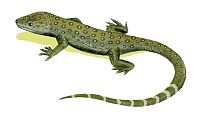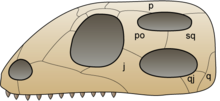User:Tony Sidaway/Reptilia
This page is for personal notes on the phylogenetic systematics of amniota, particularly reptilia. The key source for this is Modesto and Anderson (2004), "The phylogenetic definition of reptilia."
General notes on phylogenetic nomenclature
[edit]Types of group
[edit]Crown
[edit]A crown group is a group consisting of living representatives, and their ancestors, back to the most recent common ancestor of that group. The name was given by Willi Hennig, the formulator of phylogenetic systematics, as a way of classifying living organisms relative to extinct ones. Though formulated in the 1970s, it was not commonly used until its reintroduction in the 2000s.
Stem
[edit]A paraphyletic group whose members are more closely related to the crown group than to any other living group but are not members of the crown group. All members of a stem group are extinct. Example: archeopteryx is a member of the stem group of modern birds. It lacks some characteristics of birds but is more closely related to modern birds than any other crown group.
Branch-based definitions of clade
[edit]- From cladistics

The node-based definition of a monophyletic group (i.e. a clade) given above regards the lines in the cladogram only as a way of showing connections between taxa. This is appropriate when considering only living (extant) taxa; however, when extinct taxa are to be included in a cladogram, lines correspond to sequences of ancestors. There are two alternative ways of defining a clade which explicitly take into account the line below the branching point at the base of a clade.[1] These definitions are most notably set out in the PhyloCode.
Consider how a clade combining A and B in the diagram can be defined.
- Node-based: The node-based definition specifies A+B as the last common ancestor of A and B, and all descendants of that ancestor. It thus excludes from the clade the line below the junction of A and B. Crown groups are a type of node-based clade.
- Branch-based: A branch-based definition specifies A+B as the first ancestor of A which is not also an ancestor of C, and all descendants of that ancestor. It thus includes in the clade the line below the junction of A and B. (This type of definition was originally called "stem-based", but this was changed to avoid confusion with the term "stem group", which is parapyletic.) Total groups are a type of branch-based clade.
- Apomorphy-based: An apomorphy-based definition specifies A+B as the first ancestor of A to possess derived trait M homologously (that is, synapomorphically) with that trait in A, and all descendants of that ancestor. It thus includes in the clade only that part of the line below the junction of A and B which corresponds to ancestors possessing the apomorphy. The process of identifying and naming groups based on apomorphies is the method that most resembles classical systematics, with the proviso that cladistic taxa always denote a clade.
Note that these alternative definitions do not alter the classification of the tips of the tree, and so are equivalent if only living (extant) taxa are being considered.
More group types
[edit]Group names (nomens)
[edit]Amniota
[edit]Synapsida
[edit]
Synapsids ('fused arch') are a group of animals that includes mammals and everything more closely related to mammals than to other living amniotes. They are easily separated from other amniotes by having an opening low in the skull roof behind each eye, leaving a bony arch beneath each, accounting for their name. Primitive synapsids are usually called pelycosaurs; more advanced mammal-like ones, therapsids. The non-mammalian members are described as mammal-like reptiles in classical systematics, but are referred to as "stem-mammals" or "proto-mammals" under cladistic terminology.
Testudines
[edit]
Testudines, or turtles, (the crown group of the superorder Chelonia), characterised by a special bony or cartilaginous shell developed from their ribs that acts as a shield.
Procolophonidae
[edit]
The Procolophonids - family Procolophonidae (Superfamily Procolophonoidea)- are a group of small reptiles. Skulls have been discovered, roughly 5 cm in diameter.
They were shaped like stocky lizards, with broad-cheeked skulls. Their cheeks sported a stout backward-pointing spike. Hypsognathus, from North America, had many cheek spikes. Procolophon, the genus after which the group was named, is unusual. Their skulls resemble the turtles', sharing a posttemporal fenestra. Accordingly they have historically been classed alongside the turtles under the Anapsida.
Pareiasauria
[edit]
The Pareiasaurs - Family Pareiasauridae - are a clade of medium-sized to large herbivorous anapsid reptiles that flourished during the Permian period.
Their build was quite stocky, often with rather short tails and small heads. These ungainly-looking animals had very large bodies, ranging from 60 to 300 centimetres (2.0 to 9.8 ft) long, and weights of 600 kilograms (1,300 lb) would not have been unusual. They also had strong limbs, broad feet, and short tails. They were protected with bony scutes (osteoderms) set in the skin, as a defense against predators. Their heavy skulls were ornamented with multiple knobs and ridges.
Millerettidae
[edit]
The millerettids are an extinct group of anapsids that lived in South Africa during the Upper Permian. They were small insectivores and probably resembled modern lizards in appearance and lifestyle.
Mesosauridae
[edit]
Mesosaur ("middle lizards") were an order of small aquatic reptiles that lived during the early Permian period, roughly 299 to 280 million years ago. Mesosaurs were the first aquatic reptiles, having returned to a watery way of life after evolving on land.
Captorhinidae
[edit]
Captorhinidae (also known as cotylosaurs, root reptiles or stem reptiles) is one of the earliest and most basal reptile families. They are a clade of small lizard-like reptiles that date from the late Carboniferous through the Permian. Their skulls were much stronger than those of their relatives, the Protorothyrididae, and had teeth that were better able to deal with tough plant material.
Captorhinids have broad, robust skulls that are generally triangular in shape when seen in dorsal view. The premaxillae are characteristically downturned. Early, smaller forms possessed single rows of teeth, while larger, more derived forms such as Captorhinus and Moradisaurus possessed multiple rows of teeth.
Captorhinids were once thought to be the ancestors of turtles.
Paleothyris
[edit]
Paleothyris was a small, agile, anapsid reptile which lived in the Middle Pennsylvanian epoch in Nova Scotia (approximately 312 to 304 million years ago). Paleothyris had sharp teeth and large eyes, meaning that it was a nocturnal hunter. It was about a foot long. It probably fed on insects and other smaller animals found on the floor of its forest home. Paleothyris was an early sauropsid, yet it still had some features that were more primitive, more tetrapod-like than reptile-like, especially its skull, which lacked fenestrae, holes found in the skulls of most modern reptiles and mammals.
Araeoscelidia
[edit]
Araeoscelidia or Araeoscelida is a clade of extinct diapsid reptiles superficially resembling lizards, extending from the Late Carboniferous to the Early Permian. The group contains the genera Araeoscelis, Petrolacosaurus, the possibly aquatic Spinoaequalis, and less well-known genera such as Kadaliosaurus and Zarcasaurus. This clade is considered to be the sister group to all (currently known) later diapsids.
Sauria
[edit]
Sauria is a clade of reptiles that includes all living diapsids, as well as their common ancestor and all its extinct descendants. The ancestral saurian was probably a small lizard-like creature living in the Permian Period. This crown group is diagnosed by a number of details in skull and skeleton, and comprises the two important clades Lepidosauromorpha and Archosauromorpha.
The term "Sauria" has previously been used as a synonym of Lacertilia, a suborder of Squamata that includes all lizards but excludes snakes. This classification is rarely used today because Sauria so-defined is a paraphyletic group.
More on amniota
[edit]Anapsidae
[edit]
An anapsid is an amniote whose skull does not have openings near the temples.
Diapsidae
[edit]
Diapsids ("two arches") are a group of reptiles that developed two holes (temporal fenestra) in each side of their skulls, about 300 million years ago during the late Carboniferous period. Living diapsids are extremely diverse, and include all crocodiles, lizards, snakes, and tuatara. Under modern classification systems, even birds are considered diapsids, since they evolved from diapsid ancestors and are nested within the diapsid clade. While some diapsids have lost either one hole (lizards), or both holes (snakes), or even have a heavily restructured skull (modern birds), they are still classified as diapsids based on their ancestry. There are at least 7,925 species of diapsid reptile existing in environments around the world today (over 14,600 when birds are included).
Groups outside amniota
[edit]More on general systematics
[edit]Reptiles
[edit]Originally "primarily distinguished from birds and mammals by poikilothermy and lack of integumentary features such as hair and feathers (e.g., Zittel, 1902), a concept that lasted well into the succeeding (19th) century."
But then "species of the groups Pelycosauria, Dinocephalia, Dicynodontia, and Theriodontia came to be known colloquially as “mammal-like reptiles,” and were eventually placed formally within their own taxon, Synapsida, which was established as a Subclass of Reptilia (Osborn, 1903)."
Haeckel in 1866 recognised that birds, mammals reptiles were distinguishable from amphibians so he placed the former three in their own group, the amniotes. The name didn't stick, but the concept was accepted.
With the arrival of phylogenetic systematics the classification evolved.
"The emerging consensus (Gauthier et al., 1988a; Laurin and Reisz, 1995) divided amniotes into two main groups: synapsids on one hand, and all remaining amniotes on the other (Fig. 1a and b). Synapsida was defined as a stem-based group with Mammalia as its crown (Rowe, 1988), whereas Reptilia was defined as a node-based group using extant turtles, snakes, lizards, and crocodiles as reference taxa (Gauthier et al., 1988a)."
